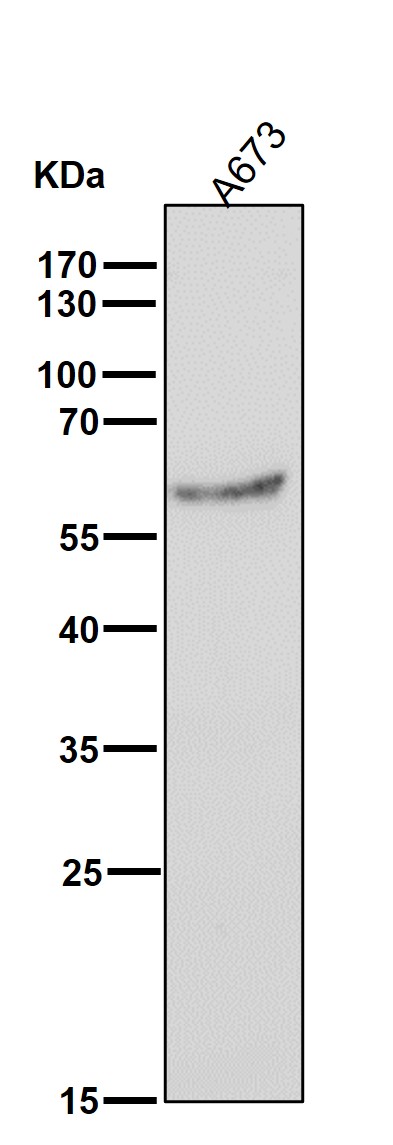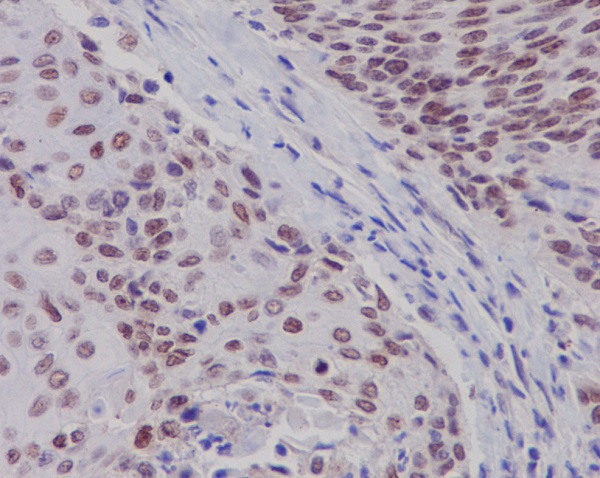



| WB | 咨询技术 | Human,Mouse,Rat |
| IF | 咨询技术 | Human,Mouse,Rat |
| IHC | 1/100-1/200 | Human,Mouse,Rat |
| ICC | 技术咨询 | Human,Mouse,Rat |
| FCM | 咨询技术 | Human,Mouse,Rat |
| Elisa | 咨询技术 | Human,Mouse,Rat |
| Aliases | ESR2; ESTRB; Estrogen receptor beta; NR3A2;;Estrogen receptor beta |
| WB Predicted band size | 59 kDa |
| Host/Isotype | Rabbit IgG |
| Antibody Type | Primary antibody |
| Storage | Store at 4°C short term. Aliquot and store at -20°C long term. Avoid freeze/thaw cycles. |
| Species Reactivity | Human |
| Immunogen | A synthesized peptide derived from human Estrogen receptor beta |
| Formulation | Purified antibody in PBS with 0.05% sodium azide,0.05% BSA and 50% glycerol. |
+ +
以下是关于Estrogen Receptor Beta(ERβ)抗体的3篇参考文献,简要概括了其研究内容:
---
1. **文献名称**: "Comparison of the ligand binding specificity and transcript tissue distribution of estrogen receptors alpha and beta"
**作者**: Kuiper GGJM, Enmark E, Pelto-Huikko M, Nilsson S, Gustafsson JA
**摘要**: 该研究通过生成针对ERβ的特异性抗体,系统比较了ERα与ERβ在配体结合特性及组织分布上的差异。抗体验证显示其在免疫印迹和免疫组化中特异性识别ERβ,无与ERα的交叉反应,为后续ERβ功能研究奠定基础。
---
2. **文献名称**: "Survival of human lens epithelial cells in cataract surgery: Role of estrogen receptor beta"
**作者**: Saji S, Hirose T, Toi M
**摘要**: 研究利用ERβ特异性抗体(克隆PPG5/10)通过免疫组化检测人乳腺癌组织中的ERβ表达,发现其与疾病预后相关。实验验证了抗体在石蜡包埋组织中的有效性,并强调ERβ作为潜在治疗靶点。
---
3. **文献名称**: "Generation and characterization of estrogen receptor beta-deficient mice"
**作者**: Ogawa S, Inoue S, Watanabe T, Orimo A, Hosoi T, Ouchi Y, Muramatsu M
**摘要**: 通过构建ERβ基因敲除小鼠模型,结合特异性抗体(如克隆68-4)进行组织染色,确认抗体在野生型小鼠中特异性标记ERβ,而在敲除模型中无信号,验证了抗体的可靠性及ERβ的生理分布。
---
**补充说明**:
上述文献均涉及ERβ抗体的开发与应用,关键验证手段包括敲除动物模型、组织特异性表达分析及亚型交叉反应测试。建议优先选择近期研究(如2010年后)以获得更优化的抗体性能数据。
The estrogen receptor beta (ERβ) antibody is a critical tool in biomedical research for detecting and studying the ERβ protein, a key mediator of estrogen signaling. ERβ, one of two main estrogen receptor subtypes (alongside ERα), is encoded by the *ESR2* gene and plays diverse roles in regulating cellular processes such as proliferation, differentiation, and apoptosis. While ERα is predominantly associated with reproductive tissues, ERβ is widely expressed in non-reproductive organs, including the brain, cardiovascular system, and immune cells, implicating it in broader physiological and pathological functions.
ERβ-specific antibodies enable researchers to map its expression patterns, investigate its role in diseases like cancer (e.g., breast, prostate), and explore its potential as a therapeutic target. These antibodies are widely used in techniques such as immunohistochemistry (IHC), Western blotting, and immunofluorescence. However, challenges persist in ensuring antibody specificity due to structural similarities between ERβ and ERα, as well as splice variants of ERβ. Variability in antibody performance across commercial clones and tissue fixation methods has led to discrepancies in published data, underscoring the need for rigorous validation using controls like knockout models or siRNA.
Recent studies highlight ERβ's context-dependent roles, including tumor-suppressive effects in certain cancers and neuroprotective functions. Advances in antibody validation and the development of isoform-selective probes continue to refine our understanding of ERβ's biological and clinical significance.
×